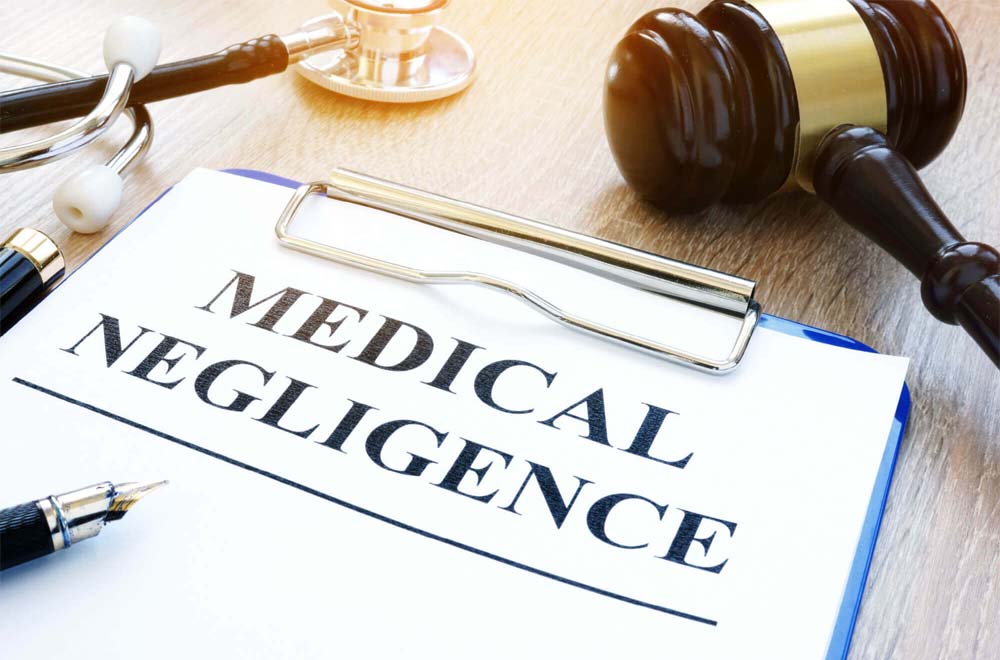Disclaimer: The Eqbal Ahmad Centre for Public Education (EACPE) encourages critical and independent thinking and believes in a free expression of one’s opinion. However, the views expressed in contributed articles are solely those of their respective authors and do not necessarily reflect the position or policy of the EACPE.
Introduction
Medical negligence is an act of omission by a health-care provider, for example, physician, surgeon, dentist, paramedical staff, pharmacist or any other health service provider. This is such act which is not their standard of practice and results in the patient’s injury or even death. The major constituents of medical negligence are as follows (Morales, 2012):
The health-care provider owed a duty of care.
The health-care provider did not take enough care.
The plaintiff (patient) suffered compensable harm.
The harm was a result of the behavior/breach of duty of the health-care provider.
Medical negligence is the absence of rational care and ability of a medical practitioner regarding the patient, whether it is noting case history or doing a clinical investigation of the patient, diagnosis and treatment, the outcome of which is injury, death or an adverse result (Gupta, 2011/2012).
Legal implications for medical negligence in India
In India, there are several legal options governing medical negligence. The major three can be grouped as following:
-
Fundamental Rights (The Constitution of India)
-
Directive Principles of
State Policy (The Constitution of India)
-
Article 41
-
Article 42
-
Article 47
-
Indian Penal Code (IPC)
-
Section 52
-
Section 80
-
Section 82
-
Section 88
-
Section 90
-
Section 91
-
Section 92
-
Section 304-A
-
Section 337
-
Section 338
The Indian Penal Code drafted in 1860 had no provision providing punishment for causing death by negligence. Section 304A was inserted in the Code in 1870 by the Indian Penal Code (Amendment) Act 1870.
S.304A. Causing Death by Negligence: Whoever causes the death of any person by doing any rash or negligent act not amounting to culpable homicide, shall be punished with imprisonment of either description for a term which may extend to two years, or with fine, or with both.
This section applies to those offences, which fall outside the domain of sections 299 and 300, where neither intention nor knowledge to cause death is present. When any of these two elements, namely intention or knowledge is present, S. 304A has no application.
To impose criminal liability under S. 304A, it is necessary that the death should have been the direct result of rash and negligent act of the accused and that the act must be the proximate and efficient cause without the intervention of another’s negligence. It must be causa causans (immediate or operating clause); it is not enough that it may have been the causa sine quo (a necessary or inevitable cause). That is to say, there must be a direct nexus between the death of a person and the rash or negligent act of the accused.
Rash and Negligent act
Rash or negligent act is an act done not intentionally or designedly. A rash act is primarily an over-hasty act, and is thus opposed to a deliberate act, but it also includes an act which, though it may be said to be deliberate is yet done without due deliberation and caution. Negligence is the breach of a duty caused by omission to do something which a reasonable man guided by those considerations which ordinarily regulate the conduct of human affairs, would do, or the doing of something which a prudent and reasonable man would not do.
The criminality lies in running the risk or doing such an act with recklessness and indifference to the consequences.
Rashness and negligence are not the same things. Mere negligence cannot be the construed to mean rashness. Negligence is the genus of which rashness is a species. The words “rashly and negligently” are distinguishable and one is exclusive of the other. The same act cannot be rash as well as negligent. The rash or negligent act means the act which is the immediate cause of death and not any act or omission which can at most be said to be a remote cause of death. In order that rashness or negligence may be criminal it must be of such a degree as to amount to taking hazard knowing that the hazard was of such a degree that injury was almost likely to be caused thereby. The criminality lies in running the risk or doing such an act with recklessness and indifference to the consequences.
Medical Negligence & the Law related to it
Lately, Indian society has developed an awareness regarding their rights and public awareness about medical negligence is growing. The reason is that the degrading standards of medical professionalism, facilities, and the appropriateness of their therapeutic and diagnostic methods. In earlier times, people were afraid of suing doctors or hospitals, but with the passage of time, the law has played a major role in generating awareness among people regarding their rights. In Suresh Gupta V. NCT of Delhi and Anor (AIR 2004 SC 4091) the Supreme Court held that for fixing criminal liability of a doctor, the standard of negligence should not merely be lack of necessary care, attention and skill. The standard of negligence required to be proved should be so high as can be described as gross negligence or recklessness.
The Bolum rule has become a standard in medical jurisprudence in UK and in India. The Bolam v Friern HMC (1957) case (henceforth, Bolam case/rule) posits that doctors need to act with only a reasonable amount of skill, which is normally expected from a professional in the medical community. However, the rule has been criticised for the manner in which it has been applied by courts in the UK. The rule has put too much power in the hands of the medical practitioner and eroded the adjudicatory powers of the court with respect to cases of medical negligence (Brazier and Miola 2000). Under the Bolam rule, doctors not only prescribe the standards to be followed by members of the profession, but also suggest how the transgressions of their peers are to be judged (Brazier and Miola 2000). Although the rule is derived from an English tort law case, it is widely used by Indian courts. Since some cases refer to the ratio laid down in the Bolam case without referring to the rule itself, there are indications that Achutrao Haribhau Khodwa v State of Maharasthra (1996), Dr Laxman Balakrishna Joshi v Dr Trimbak Bapu Godbole (1969) and the Indian Medical Association v VP Shanta (1995) were some of the first cases to use the Bolam case. The Jacob Mathew v State of Punjab (2005) case is one of the cases that explicitly refers to the Bolam rule. It held that the Bolam rule could be used to determine whether a medical practitioner has been negligent, and made a declaration that the rule would be applicable in India. In Bolitho v City and Hackney Health Advisory (1996; henceforth, the Bolitho case), an infant died due to cardiac arrest. The nurse alerted the doctor in charge that the child’s condition was getting worse. However, the doctor did not come to check on the infant and intubate (insert a tube into the trachea for ventilation), or send a deputy to do so. It was known to the court that had the child been intubated, the cardiac arrest could have been prevented. There was a divergence of medical opinion at that time with respect to whether the infant should have been intubated based on the information about her condition at the time of the cardiac arrest. Thus, the defence argued that even if the doctor was present, she would not have intubated the patient. Based on this rationale, the trial court acquitted the doctor. The House of Lords upheld this decision of the trial court on appeal, but the reasoning of the House of Lords showed its willingness to move away from the erstwhile deference to the Bolam test, shown by the court. It held that courts would be allowed to choose between differing medical opinions based on standards such as the reasonableness of the opinion, how responsibly it was made and acted upon, and whether it could withstand “logical analysis.” Thus, courts were no longer forced to err on the side of caution and refrain from finding a doctor guilty of negligence because there were differing medical opinions.The House of Lords decision in the Bolitho case reinterpreted the Bolam rule by holding that the courts would always be the fi nal arbiters of whether or not there has been any negligence. The Bolitho case used the Bolam rule to determine the level of skill required from a doctor. However, what changed in the Bolitho case was that it required what was considered to be the reasonable level of skill or course of action to withstand logical analysis. This is significant as until Bolitho, when presented with differing medical opinions, the court decided to choose neither and absolved the doctor of liability as their course of action was considered reasonable by some responsible members of the profession (the Bolam rule in its purest form). After the Bolitho case, expert opinions would still be given by the members of the profession, but the evaluation of the persuasiveness of these opinions was left to the courts.
In the case of Johnson & Johnson (Editorial, “J&J to pay $ 2.5b for faulty hip implants” The Times of India, Dec. 4, 2013) in which company had agreed to pay $ 2.5 billion (over Rs 15,000 crore) as compensation to around 8,000 U.S citizens who had sued the company after being fitted with its faulty hip implants. It was revealed that the implant metals cobalt and chromium were leaving debris in the body which led to fluid accumulation in joints and muscles causing pain or discomfort and heightening chances of metal poisoning. However the scenario in the US contrasts gratingly with India. In India about 4,500 patients had received the implant and there is only one reported case against the company in consumer court. The patients are ignorant and have remained in the dark about the dangers the implant poses and the global outcry against it. A large number of patients have remained under pain or have gone for further surgeries unaware about the effects of the implant. This is the present scenario with regard to liability for medical devices.
Kunal Saha Vs AMRI (Advanced Medical Research institute ) famously known as Anuradha Saha Case, this case was filed in 1998 with the allegation of medical negligence on Kolkata based AMRI Hospital and three doctors namely Dr. Sukumar Mukherjee, Dr. Baidyanath Halder and Dr. Balram Prasad. In simple layman term, the wife was suffering from drug allergy and the doctors were negligent in prescribing medicine which further aggravated the condition of patient and finally led to death. In brief this was the facts and circumstances of the case, in this case the final verdict was given by the Supreme court on 24th October 2013 and a compensation of around 6.08 crore for the death of his wife.
In the case of V.Krishan Rao Vs Nikhil Super Speciality Hospital 2010, Krishna Rao, an officer in malaria department filed a complaint against the hospital for negligent conduct in treating his wife. His wife was wrongly treated for typhoid fever instead of malaria fever, due to the wrong medication provided by the hospital. Finally, the verdict was given and Rao was awarded a compensation of Rs 2 lakhs. In this case, the principle of res ipsa loquitor (thing speak for itself) was applied and the compensation was given to the plaintiff.
There are few exceptions available to medical practitioners which they can exercise e.g. Sections 80 and 88 of the Indian Penal Code contain defences for doctors accused of criminal liability. Under Section 80 (Accident in doing a lawful act) ‘nothing is an offense that is done by accident or misfortune and without any criminal intention or knowledge in the doing of a lawful act in a lawful manner by lawful means and with proper care and caution.’ According to Section 88 ‘a person cannot be accused of an offense if she/ he performs an act in good faith for the other’s benefit, does not intend to cause harm even if there is a risk, and the patient has explicitly or implicitly given consent.’
The position regarding negligence under civil law is very important as it encompasses many elements within itself. Under the torts law or civil law, this principle is applicable even if medical professionals provide free services. It can be asserted that where Consumer Protection Act ends, tort law begins.
A division bench of Tripura High Court consisting of Chief Justice Akil Kureshi and Justice SG Chattopadhyay on Monday ordered the State of Tripura to pay a compensation of Rs. 10,00,000 in a case of death of an advocate namely Bhaskar Debroy after it was found that the he died due to medical negligence of GBP hospital. The bench relied on the case of Leela Shamji & Ors. v. BYL Nair Hospital & Ors. (2019) of the Bombay High Court wherein the court while relying on the judgment of Uphaar cinema case had awarded a compensation of Rs. 10,00,000 to the petitioners where a person had died due to inhaling excessive oxygen after he was trapped between the MRI machine and Oxygen cylinder. The Court furthermore analyzed the facts of the case and held that it was a crystal clear case of res ipsa loquitur, a maxim of used in the field of medical negligence. The Court therefore ordered the award of compensation of Rs. 10,00,000 to the mother of the deceased.
Conclusion
The courts still remain the final arbiter of whether the doctors were guilty of negligence. So, it could be said that courts with the assistance of Indian Medical Association would do well to promote better professional practice among its members and to create a more meaningful environment between doctors and patients by educating the public on their rights.
References
-
Legal implications governing medical negligence in India:creating awareness through six-dimensional framework of effective communication Deepa Sethi Indian Institute of Management Kozhikode, Kozhikode, India, and Vikas Arya Department of Marketing, Rajalakshmi School of Business, Chennai, India; https://www.emerald.com/insight/1754-243X.htm
-
PSA Pillai’s, Criminal Law, Tenth Edition, 2008, Lexis Nexis, p818.
-
K D Gaur, Criminal Law: Cases & Materials, Eight Edition, 2015, Lexis Nexis, 1507
-
SN Mishra, Indian Penal Code, 16th Edition, 2008, Central Law Publications.
-
Medical Negligence and Law Application of the Bolam and Bolitho Rules in India, Special Article by M P Ram Mohan, Vishakha Raj on EPW.
-
Regulating Health Related Technologies And Medical Devices: With Special Reference To India, Author(s): N.K. Chakrabarti and Shreya Chatterjee; Source: Journal of the Indian Law Institute , April-June 2014, Vol. 56, No. 2 (April-June 2014), pp. 216-235 Published by: Indian Law Institute Stable URL: https://www.jstor.org/stable/43953702
-
-
-
Live Law (Medical Negligence – Tripura High Court orders Govt. To pay Rs. 10 lakhs compensation to Mother of Deceased Lawyer; 9:39 am, Tuesday 05 January 2021)
-
Medical Practice Shirking Responsibility; on EPW.
About the Author
Rahil Amin Mir is pursuing law at Central University of Kashmir. He can be reached at rahilaminmir@gmail.com







